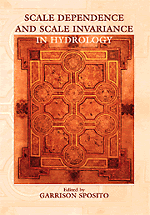Book contents
- Frontmatter
- Contents
- List of Contributors
- Preface
- 1 Scale Analyses for Land-Surface Hydrology
- 2 Hillslopes, Channels, and Landscape Scale
- 3 Scaling in River Networks
- 4 Spatial Variability and Scale Invariance in Hydrologic Regionalization
- 5 An Emerging Technology for Scaling Field Soil-Water Behavior
- 6 Scaling Invariance and the Richards Equation
- 7 Scaling of the Richards Equation and Its Application to Watershed Modeling
- 8 Scale Issues of Heterogeneity in Vadose-Zone Hydrology
- 9 Stochastic Modeling of Scale-dependent Macrodispersion in the Vadose Zone
- 10 Dilution of Nonreactive Solutes in Heterogeneous Porous Media
- 11 Analysis of Scale Effects in Large-Scale Solute-Transport Models
- 12 Scale Effects in Fluid Flow through Fractured Geologic Media
- 13 Correlation, Flow, and Transport in Multiscale Permeability Fields
- 14 Conditional Simulation of Geologic Media with Evolving Scales of Heterogeneity
- Index
9 - Stochastic Modeling of Scale-dependent Macrodispersion in the Vadose Zone
Published online by Cambridge University Press: 18 January 2010
- Frontmatter
- Contents
- List of Contributors
- Preface
- 1 Scale Analyses for Land-Surface Hydrology
- 2 Hillslopes, Channels, and Landscape Scale
- 3 Scaling in River Networks
- 4 Spatial Variability and Scale Invariance in Hydrologic Regionalization
- 5 An Emerging Technology for Scaling Field Soil-Water Behavior
- 6 Scaling Invariance and the Richards Equation
- 7 Scaling of the Richards Equation and Its Application to Watershed Modeling
- 8 Scale Issues of Heterogeneity in Vadose-Zone Hydrology
- 9 Stochastic Modeling of Scale-dependent Macrodispersion in the Vadose Zone
- 10 Dilution of Nonreactive Solutes in Heterogeneous Porous Media
- 11 Analysis of Scale Effects in Large-Scale Solute-Transport Models
- 12 Scale Effects in Fluid Flow through Fractured Geologic Media
- 13 Correlation, Flow, and Transport in Multiscale Permeability Fields
- 14 Conditional Simulation of Geologic Media with Evolving Scales of Heterogeneity
- Index
Summary
Introduction
Quantitative field-scale descriptions of chemical transport in the unsaturated (vadose) zone are essential for improving our basic understanding of the transport process in near-surface geologic environments and for sharpening the predictive tools that in turn will be used to predict the future spread of pollutants in these environments. The traditional approach to modeling transport processes in the vadose zone has been to model water flow and solute transport by using the macroscopic physical and chemical properties of the soil that vary in a deterministic manner, obey physical and chemical laws, and are expressed in the form of partial differential equations.
One of the distinctive features of a natural formation at the field scale, however, is the spatial heterogeneity of its properties (e.g., Nielsen, Biggar, and Erh, 1973; Russo and Bresler, 1981; Ünlü, Kavvas, and Nielsen, 1989; Russo and Bouton, 1992). This spatial heterogeneity is generally irregular, and it occurs on a scale beyond the scope of laboratory samples. These features have distinct effects on the spatial distributions of solute concentrations that result from transport through the heterogeneous porous formations, as has been observed in field experiments (e.g., Schulin et al., 1987; Butters, Jury, and Ernst, 1989; Ellsworth et al, 1991; Roth et al., 1991) and demonstrated by simulation (e.g., Russo, 1991; Russo, Zaidel, and Laufer, 1994; Tseng and Jury, 1994) of solute transport in unsaturated, heterogeneous soils.
Inasmuch as a deterministic description of a heterogeneous soil is, for practical purposes, impossible, a fundamental question is how to develop predictive models that can incorporate the impacts of the field-scale spatial variabilities of soil properties on vadose-zone flow and transport.
- Type
- Chapter
- Information
- Scale Dependence and Scale Invariance in Hydrology , pp. 266 - 290Publisher: Cambridge University PressPrint publication year: 1998
- 3
- Cited by



